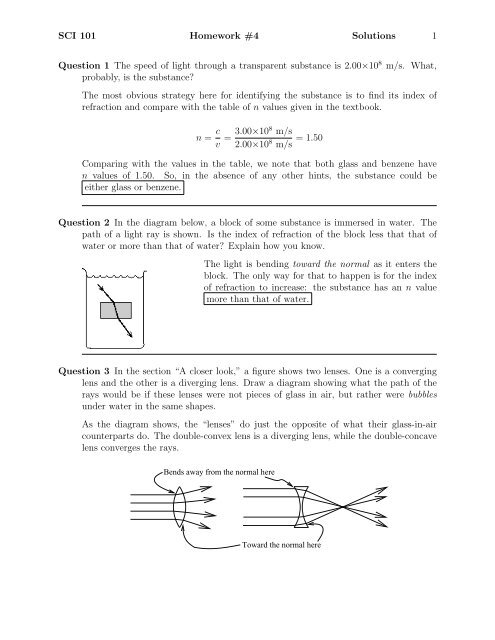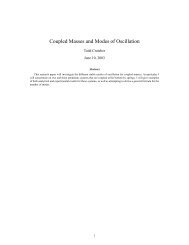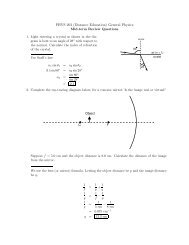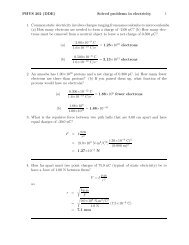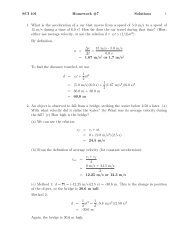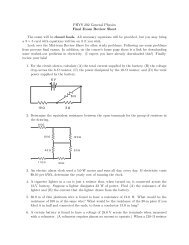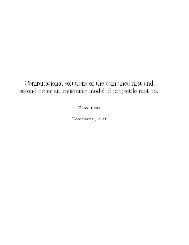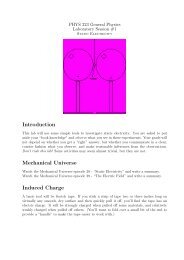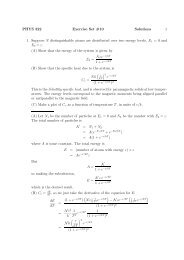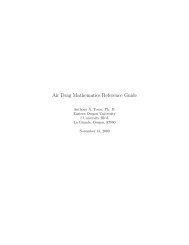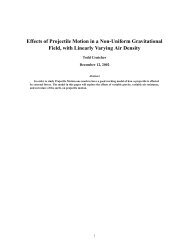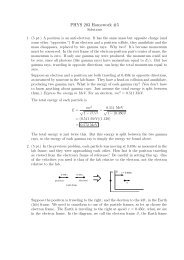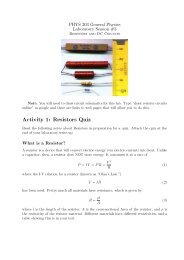SCI 101 Homework #4 Solutions 1 Question 1 The speed of light ...
SCI 101 Homework #4 Solutions 1 Question 1 The speed of light ...
SCI 101 Homework #4 Solutions 1 Question 1 The speed of light ...
Create successful ePaper yourself
Turn your PDF publications into a flip-book with our unique Google optimized e-Paper software.
<strong>SCI</strong> <strong>101</strong> <strong>Homework</strong> <strong>#4</strong> <strong>Solutions</strong> 1<br />
<strong>Question</strong> 1 <strong>The</strong> <strong>speed</strong> <strong>of</strong> <strong>light</strong> through a transparent substance is 2.00×10 8 m/s. What,<br />
probably, is the substance<br />
<strong>The</strong> most obvious strategy here for identifying the substance is to find its index <strong>of</strong><br />
refraction and compare with the table <strong>of</strong> n values given in the textbook.<br />
n = c v = 3.00×108 m/s<br />
2.00×10 8 m/s = 1.50<br />
Comparing with the values in the table, we note that both glass and benzene have<br />
n values <strong>of</strong> 1.50. So, in the absence <strong>of</strong> any other hints, the substance could be<br />
either glass or benzene.<br />
<strong>Question</strong> 2 In the diagram below, a block <strong>of</strong> some substance is immersed in water. <strong>The</strong><br />
path <strong>of</strong> a <strong>light</strong> ray is shown. Is the index <strong>of</strong> refraction <strong>of</strong> the block less that that <strong>of</strong><br />
water or more than that <strong>of</strong> water Explain how you know.<br />
<strong>The</strong> <strong>light</strong> is bending toward the normal as it enters the<br />
block. <strong>The</strong> only way for that to happen is for the index<br />
<strong>of</strong> refraction to increase: the substance has an n value<br />
more than that <strong>of</strong> water.<br />
<strong>Question</strong> 3 In the section “A closer look,” a figure shows two lenses. One is a converging<br />
lens and the other is a diverging lens. Draw a diagram showing what the path <strong>of</strong> the<br />
rays would be if these lenses were not pieces <strong>of</strong> glass in air, but rather were bubbles<br />
under water in the same shapes.<br />
As the diagram shows, the “lenses” do just the opposite <strong>of</strong> what their glass-in-air<br />
counterparts do. <strong>The</strong> double-convex lens is a diverging lens, while the double-concave<br />
lens converges the rays.<br />
Bends away from the normal here<br />
Toward the normal here
<strong>SCI</strong> <strong>101</strong> <strong>Homework</strong> <strong>#4</strong> <strong>Solutions</strong> 2<br />
<strong>Question</strong> 4 In the lab, we covered a lens with a half-dozen pinholes in a piece <strong>of</strong> foil.<br />
Describe what happened to the images <strong>of</strong> the <strong>light</strong> bulb filament, when we moved the<br />
screen toward and away from the lens.<br />
Sorry! This is a duplicate <strong>of</strong> a question on the previous homework set.<br />
<strong>Question</strong> 5 How would you describe the character qualities <strong>of</strong> Galileo’s son, Vincenzio,<br />
when he was in his teens (Reference the section <strong>of</strong> Galileo’s Daughter on which you<br />
base your answer.)<br />
He seems at age 17 to be “the sullen, thankless opposite <strong>of</strong> his industrious older sister”<br />
(Sobel, p. 119). At college in Pisa, he was not careful with money and severely tried<br />
the goodwill <strong>of</strong> Galileo’s friend who was supposed to look after him. Overall, not a son<br />
to be proud <strong>of</strong>. He seems to have matured somewhat by the time he married.<br />
<strong>Question</strong> 6 What was the point <strong>of</strong> Galileo’s “parable” <strong>of</strong> the cicada, in his pamphlet <strong>The</strong><br />
Assayer <br />
<strong>The</strong> main point seems to be that though men may understand a great many <strong>of</strong> the<br />
workings <strong>of</strong> nature, those workings are so deep and varied that men can never learn<br />
all. A corollary is that the more men learn, the more they ought to be humbled by the<br />
marvelous workings <strong>of</strong> the Creator.<br />
<strong>Question</strong> 7 What was the recurring problem troubling the Poor Clares, about which Maria<br />
Celeste asked her father to speak to the Pope In the context <strong>of</strong> answering this question,<br />
describe those who were “more suited to hunting rabbits than guiding souls.”<br />
<strong>The</strong>y had trouble getting quality priests to administer the sacraments and perform<br />
other rites which women were not allowed to perform. <strong>The</strong> “fathers” they were assigned<br />
were <strong>of</strong>ten abysmally ignorant and uneducated; moreover, they <strong>of</strong>ten lacked the moral<br />
fiber necessary to properly act the part <strong>of</strong> a priest to a company <strong>of</strong> women, <strong>of</strong>ten taking<br />
advantage <strong>of</strong> their authority in improper ways. Since the fathers were supposed to be<br />
paid for their services, the convent ended up in debt to them, and some <strong>of</strong> the priests<br />
took advantage <strong>of</strong> this; forcing the sisters to allow them to dine with the nuns and,<br />
as Maria Celeste puts it, “fraternize with several <strong>of</strong> the nuns.” Maria Celeste asked<br />
Galileo to intercede with the Pope so that they would be sent confessors <strong>of</strong> a higher<br />
quality and those which were truly pious, educated in the doctrines <strong>of</strong> the church and<br />
the customs <strong>of</strong> the convents, and not greedy for money and other favors. She even<br />
suggested a particular order <strong>of</strong> monks, from the Reformed Carmelites <strong>of</strong> Santa Maria<br />
Maggiore.


